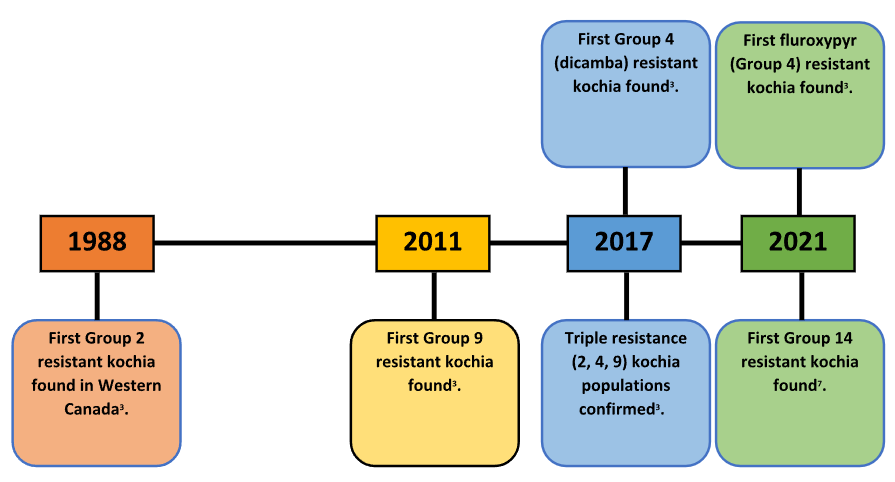

Since the first herbicide resistant kochia population was found, resistance has rapidly spread and evolved. So much so that all kochia plants are considered group 2 resistant[8]. This is due to the nature of the plant’s reproduction. Kochia will cross pollinate before it self pollinates, leading to genetics, like herbicide resistance, passing on more easily[8]. In Manitoba in 2018, 58% of the kochia population was resistant to group 9 (glyphosate); only 1% was resistant to group 4[9]. We suspect that we have kochia populations in this area with group 9 resistance, but herbicide testing would need to be done to confirm.
Since kochia is so prone to resistance, we can not strictly rely on herbicides to manage the weed. An integrated pest management strategy must be used. Management strategies, both cultural and chemical, are listed below. Not every method is going to be a fit for your operation, but by choosing those that are, a management plan can be implemented.
Cultural
Tillage – can be used as a management technique but needs to be done early in its growth cycle[6].
Manage Saline Areas – kochia thrives in areas with little competition, like saline areas. Seeding these patches down to salt tolerant forages will promote competition[6].
Diverse Crop Rotations – Incorporate crops into rotation with different life cycles, such as perennials and winter annuals, as well as early seeded versus late seeded crops. By varying crop and seeding dates, different herbicides can be used in rotation. Forages have many benefits in controlling kochia as they are very competitive, and the top growth of the weed is removed when cutting hay. Kochia is as nutritious and palatable as alfalfa[6]. If using as feed, it should be cut before the weed produces seed[3].
Winter wheat is a good crop to incorporate into rotation as it is very competitive in spring and is harvested before kochia produces seed[10].
Competitive Crop – increasing seeding rates and decreasing row spacing both make your crop as competitive as possible[3],[8].
Scout – scout early and often, being sure to check for herbicide efficacy[8].
Harvest Weed Seed Control – this management technique began in Australia but is becoming more popular in Western Canada. The weed seeds are destroyed once they go through the seed destructor mounted on the back of the combine. For this to be effective the weeds need to retain their seed at harvest timing and produce seeds at a height the header will pick up[11]. This is possibly a technology to investigate in the future but is likely not a realistic management strategy to rely on currently.
Chemical
Apply Herbicides Early – kochia is much easier to control when it is small[8]. Most herbicides stop controlling kochia once it is larger than the 8-leaf stage.
Herbicide Layering – use multiple modes of action at different timings that are all effective on kochia. Use a combination of foliar and soil applied products, as well as tank mixing chemicals to help prevent further resistance[12]. An example of herbicide layering in both wheat and canola:

Pre-seed and in-crop herbicides used should be different groups in case there is populations within the field that are resistant to either group[12].
Chemical Control in Wheat
Kochia is a lot easier to manage in cereals than other crops[5]. There are multiple products registered ahead of wheat for residual control of the weed – this is ideal as kochia is a flushing weed. Authority and Voraxor are both group 14’s applied pre-seed or pre-emerge for flushing control (Authority) and flushing suppression (Voraxor) of kochia and other annual broadleaves. Both require moisture to activate. Authority can also be applied in the fall.
In-crop herbicides include Akito (Groups 2 + 4), Axial Xtreme iPak (1,4,6,27), Infinity FX (4,6,27), Pixxaro (4), Prominex (4), Rezuvant XL (1,4) and others not listed here.
Chemical Control in Canola
Control of kochia in canola is dependent on the herbicide system used. Clearfield Canola should not be grown on fields with any kochia pressure, as Ares (2) will not control it. The Roundup Ready system should not be grown on fields with glyphosate resistant kochia populations. Glufosinate (10) is very effective on the weed[8], making Liberty Link or dual trait varieties the best options. It is important to note that when growing dual trait canola, the volunteers will require more careful management in the following years.
We recommend applying Edge (3) in the fall or spring ahead of canola for flushing control of kochia as well as other broadleaves and grassy weeds. Prospect (4 + 14) and Certitude (6 + 27) are also registered for control of kochia, but there is no residual control. The only plants that will be controlled are those already emerged.
Chemical Control in Peas and Soybeans
Kochia needs to be controlled pre-emerge in peas, as Odyssey Ultra Q (2) will not control it and Viper ADV (2 + 6) is suppression only. Edge, Authority, Voraxor and Voraxor Complete are all registered ahead of peas and soybeans.
Depending on the variety and its herbicide system, Dicamba (4), 2,4-D (4) and/or Glufosinate will all control kochia in soybeans.
A full list of products registered for control of kochia can be found in the Guide to Field Crop Production.
Reach out to a Prairie Giants agronomist with any questions about kochia or to develop a management strategy for your operation.